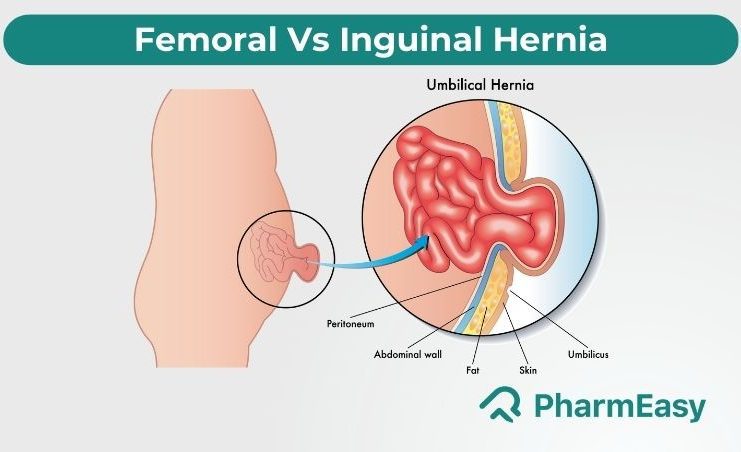Difference Between Femoral And Inguinal Hernia
By Saksham Bhatia +2 more

Get more insightful and
helpful tips to
treat Diabetes for FREE



Download PharmEasy App




Register to Avail the Offer
Send OTPBy continuing, you agree with our Privacy Policy and Terms and Conditions
By Saksham Bhatia +2 more
Table of Contents
A femoral hernia is a rare type of hernia, it usually occurs when fatty tissue or a part of your bowel protrudes into your groin, which is the area of your hip joint. It pushes through a weak spot in the abdominal wall into an area called the femoral canal.

An inguinal hernia occurs when part of the intestine protrudes through a weak spot in the abdominal muscles from the region of the inguinal canal. The bulge can be painful and noticeable when you cough, bend over or lift a heavy object. An inguinal hernia can lead to life-threatening complications if not treated timely.
During the natural course of time, hernias usually become larger, and you will experience symptoms of pain, discomfort, and fullness in your groin or stomach, which will eventually limit your activities. The larger a hernia becomes, the harder it is to repair. The only lasting treatment is surgical repair.
Dr. Ashish Bajaj, M.B.B.S., M.D.
| Different factors | Femoral Hernia | Inguinal Hernia |
| Causes | Straining while passing tools Constipation Obesity Lifting or pushing heavy loads | Increased pressure within the abdomen A weak spot in the abdominal wall after an injury or surgery. Performing strenuous activities Chronic coughing Pregnancy |
| Symptoms | A painful lump The bulge is prominent while coughing, straining and lifting The lump can often be pushed back in or disappears when you lie down. | A bulge on both sides of your pubic bone A burning or aching sensation at the bulge Groin pain and discomfort Weakness and a heavy sensation in your groin Pain and swelling around the testicles in men The bulge can descend through the scrotum in men It passes through the inguinal canal Discomfort or pain while standing for too long |
| Diagnosis | Physical examination. The doctor may ask you to cough or strain while standing to examine the bulge properlyImaging tests include CT Scan or MRI, Abdominal X-Ray and Ultrasound. | Imaging tests like Abdominal X-ray Computerized tomography (CT) scan/MRI Ultrasound |
| Treatment options that can be advised by doctors | Open surgery- a cut is made to allow the surgeon to push the lump back into its place and the abdominal wall is repaired with a mesh. Laparoscopic surgery – It is keyhole surgery, less invasive, allows the surgeon to use various medical tools to look inside the abdomen and repair the hernia. | Open surgery or Hernioplasty Laparoscopic surgery |
| Prevalence | Common in women, especially older women | Men are at a higher risk of developing inguinal hernia than women |
| Complications | Complications that can develop as a result of a femoral hernia include: Obstruction – a section of the bowel gets stuck in the femoral canal, causing nausea, vomiting and stomach pain and a painful lump in the groin Strangulation – a section of the bowel becomes trapped and its blood supply is cut off. This requires emergency surgery. | Pressure on surrounding tissues due to enlargement of the hernia. It can extend into the scrotum, causing pain and swelling. Strangulated Hernia. This occurs when the blood flow to part of your intestine is cut off from its blood supply. It affects bowel tissue and can be a life-threatening condition which requires immediate surgery. |
Approximately 80% of abdominal wall hernias are inguinal hernias and 5% are femoral hernias,inguinal hernia mainly affects men, while femoral hernia mainly affects women. A femoral hernia is a bulge in outer groin near upper thigh, inguinal hernia is in inner groin.
Dr. M.G. Kartheeka, MBBS, MD
Also Read: Groin Pain When Walking: Understanding the Causes and Solutions
Femoral and Inguinal Hernias are both types of hernias with very similar symptoms, they can cause pain, a bulge near the groin, heaviness and discomfort. If you notice any of these symptoms, there are chances that you may confuse the two conditions. Book an appointment with a general physician and get yourself diagnosed at the earliest. Learning the difference between femoral hernias and inguinal hernias is important. Surgery may be recommended for your condition as it is the only treatment option for a hernia. There are no other alternative medicines and leaving the conditions untreated for a long time may cause other complications. Never self-medicate and always follow the doctor’s advice.
Disclaimer: The information included on this site is for educational purposes only and is not intended to be a substitute for medical treatment by a healthcare professional. Because of unique individual needs, the reader should consult their physician to determine the appropriateness of the information for the reader’s situation.

Leave your comment...
Comments